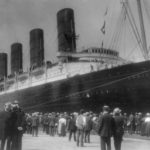Dead Wake
No, Wake Island isn’t dead. I know I make a connection to Wake Island in just about every blog post (it turns out that there are generally six or fewer degrees of separation), but this post is about the recent book by Seattle’s Erik Larson: Dead Wake: The Last Crossing of the Lusitania (Broadway Books, 2015). The skilled narrative non-fiction author of In the Garden of the Beasts and The Devil in the White City turns here to the well-known but still gripping story of the massive luxury ocean liner, sailing from New York to Liverpool in 1915, sunk by a German U-boat off the coast of Ireland. Moments before the attack, the track of the killer torpedo “lingered on the surface like a long pale scar,” a “trail of fading disturbance” on the water that Larson explains was called a “dead wake” in maritime vernacular.
While not as famous in the public imagination as the Titanic collision with an iceberg, the Lusitania story offers deeper context with its relevance to the events of World War I. Before reading Larson’s book, I knew little about the Lusitania except that a German submarine torpedoed it and the loss of American lives contributed to the U. S. decision to enter the war. It turns out that – no surprise – it’s more complicated. Larson digs into the many layers and historical intersections that underlie the Lusitania story, and brings life (and, for too many on that ship, death) to a myriad of characters both famous and obscure. In his familiar narrative non-fiction style, the author targets multiple perspectives, exploring each in several turns as the chronology builds to the fateful attack on May 7, 1915.
The sinking of the Lusitania was not the catalyst for U. S. entry into WWI: two years elapsed before the United States committed to the war effort. While Americans generally deplored German submarine warfare against Britain, especially as it expanded to include commercial and neutral shipping, and were shocked by the Lusitania disaster, it was still Europe’s war. Closer to home was trouble with Mexico: Pancho Villa’s forces attacked Americans in 1916 and, what really got the attention of the Wilson Administration was a leaked telegram from a German official promising Mexico a tasty share of U. S. territory if Mexico allied with Germany to win the war. This shocker plus Germany’s escalation of unrestricted submarine warfare that was taking a toll on American ships and lives finally brought the U.S. into the war by congressional resolution in April 1917.
One of the most intriguing angles that Larson explores is the top-secret section of the British Admiralty known as “Room 40” where a handful of officials and analysts decoded intercepted German messages. They knew where the U-boats prowled in home waters and were tracking the very submarine that sank the Lusitania off the coast of Ireland in May 1915. Records show that as the Lusitania approached its destination, despite the known dangers (generally to the public, but specifically to the Admiralty), the ship was given neither protective escort nor specific directives for evasive maneuvers. Larson suggests that elements within the Admiralty were “baiting the hook;” in this case, enabling a spectacular attack that would bring the U. S. into the war. In a confidential letter that spring, Winston Churchill (then First Lord of the Admiralty and member of the Room 40 elite) wrote that it was “most important to attract neutral shipping to our shores, in the hopes especially of embroiling the United States with Germany.” Not coincidentally, Room 40 was the source of the leaked Zimmerman telegram to Mexico two years later.
Larson weaves multiple strands together in Dead Wake: the ship and its captain, crew, and passengers; the German submarine and commander; President Woodrow Wilson, Room 40, and more. I found the best-drawn perspective from under the water: the German submarine U-20 and its commander, Kptlt. Walther Schwieger. We learn how it operates, feel the isolation and claustrophobia, smell the coffee and unwashed bodies, and get inside Schwieger’s head as he hunts for targets and celebrates tonnage sunk with his crew. Next best is the Lusitania captain, William Thomas Turner, experienced, confident, gruff, and standing tall in full dress uniform at the helm in the final moments, going down with his ship, but – in the ultimate irony – surviving the sinking while so many of his crew and passengers do not. Larson’s main stage is the ship itself: the Cunard Line’s massive, swift, elegant Lusitania, veteran of hundreds of Atlantic crossings, equipped with state-of-the-art technology, lifeboats, lifejackets, and every creature comfort. On the afternoon of the disaster the sky was clear and the water quiet: the Lusitania “sliced through the calm like a razor through gelatin.”
I didn’t find the passengers that interesting, though Larson presents them in good detail, based on letters, articles, and survivor memoirs. They are a great Edwardian swirl and it’s hard to get invested in any of them. As for President Wilson, we see little but his drawn-out, embarrassing courtship of Edith Galt, who would become the second Mrs. Wilson.
The Lusitania carried 1,959 passengers and crew (plus three captured German stowaways) on that last sailing. Of the total, only 764 survived. Among the dead were 123 Americans; more than 600 of the dead were never found. U-20 fired a single torpedo, though a second explosion on board added to the catastrophe. In 2008 Irish divers with a marine archaeology expedition brought up a handful of .303 rounds from the wreck, noting that there were thousands of cases of ammunition below. The Lusitania in fact was carrying secret stores of American-made munitions bound for Britain and the war. They and the dead should remain entombed on the ocean floor.

MaritimeQuest – http://www.maritimequest.com/liners/lusitania_page_3.htm

